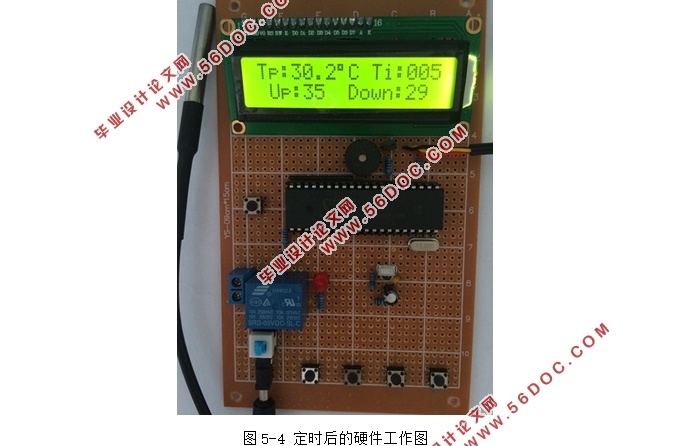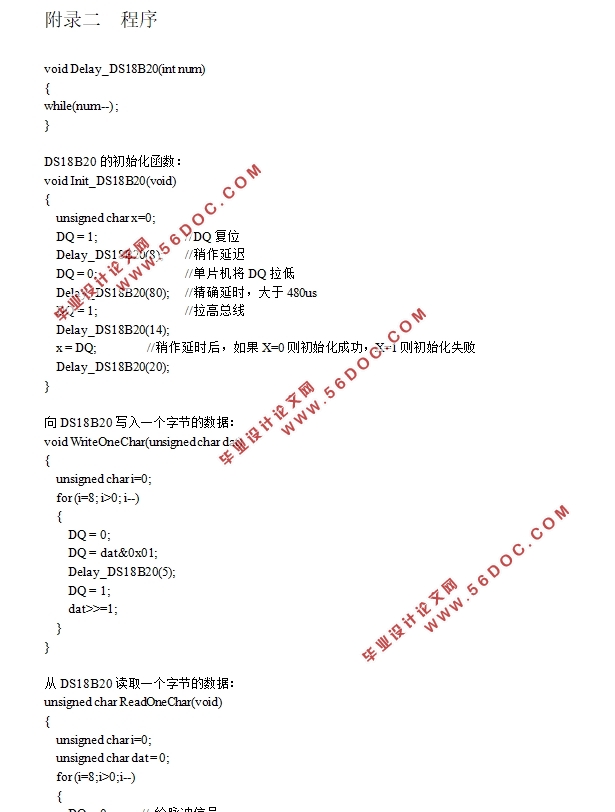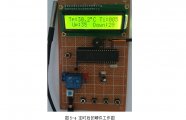基于单片机的浴霸智能控制器的设计(附程序代码)
来源:56doc.com 资料编号:5D21705 资料等级:★★★★★ %E8%B5%84%E6%96%99%E7%BC%96%E5%8F%B7%EF%BC%9A5D21705
资料以网页介绍的为准,下载后不会有水印.资料仅供学习参考之用. 密 保 惠 帮助
资料介绍
基于单片机的浴霸智能控制器的设计(附程序代码)(任务书,论文10000字,程序代码)
摘 要
随着科技的进步和社会的发展,人们对生活质量的要求越来越高,生活观念也开始转变。为了有更好的生活体验,浴霸逐渐成为家庭卫浴里必不可少的部分。
本文主要介绍了基于单片机的浴霸智能控制器的原理和实现方法。首先通过方案论证确定了本系统所采用的微处理器(STC89C52)、温度传感器(DS18B20)、显示模块(1602)、红外遥控模块。之后分别对本系统的硬件和软件部分的设计过程进行了详细的阐述。硬件部分分别对STC89C52单片机的最小系统、温度采集电路、液晶显示电路以及红外通信电路进行设计;软件部分采用KEIL和C语言完成,并且对上述各硬件模块的软件进行编程。最后,对本系统的软、硬件进行了联合调试。
测试结果表明,本系统各项功能已达到本设计的所有要求。
关键词:温度监控 智能控制 红外遥控
Yuba intelligent controller design what based on SCM
Abstract
With the development of technology and society, people are increasingly demanding high quality of life, the concept of life began to change. In order to have a better life experience in Yuba gradually become an essential part of the family bathroom.
This paper describes the principle and method based on SCM Yuba intelligent controller. First, the system used to determine the microprocessor (STC89C52) through the demonstration program, the temperature sensor (DS18B20), display module (1602), infrared remote control module. After the hardware and software are part of the design process of the system were elaborated. The hardware part respectively STC89C52 SCM minimum system temperature acquisition circuits, liquid crystal display circuit and infrared communication circuit design; software part and the C language using KEIL completed and hardware modules for each of the above software programming. Finally, the system software and hardware joint commissioning.
The test results show that the system has met all requirements of the various functions of the design.
Keywords: temperature monitoring; intelligent control; infrared remote


目 录
摘 要 I
Abstract II
第一章 绪论 1
1.1 引言 1
1.2 研究背景和意义 1
1.3 研究现状 1
1.4 论文组织结构 2
第二章 系统总体方案设计 3
2.1 总体方案 3
2.2 主控制器的选择 3
2.3 温度传感器的选择 4
2.4 显示模块的选择 5
第三章 系统硬件电路设计 6
3.1 STC89C52最小系统 6
3.1.1 电源电路 6
3.1.2 复位电路 7
3.1.3 晶振电路 8
3.2 温度采集电路 9
3.3 状态切换电路 10
3.4 液晶显示电路 12
3.5 蜂鸣器电路 14
第四章 系统软件设计 15
4.1 概述 15
4.2 主程序方案 15
4.3 各模块子程序设计 17
4.3.1 温度采集模块 17
4.3.2 液晶显示模块 19
4.3.3 状态切换模块 20
第五章 调试 22
5.1 软件调试 22
5.2 系统调试 24
第六章 总结与展望 27
参考文献 29
致 谢 30
附录一 硬件原理图 31
附录二 程序 32
|





